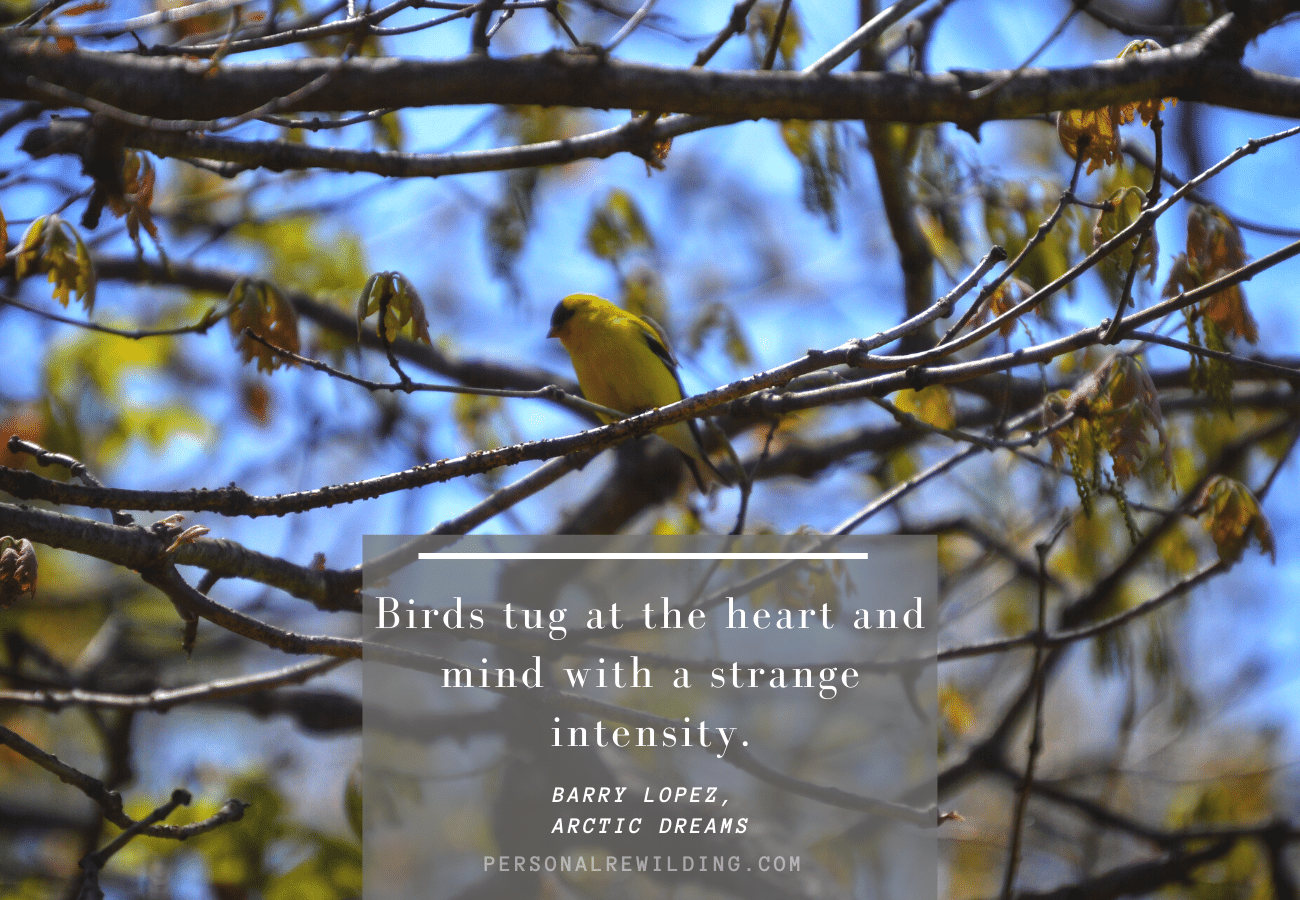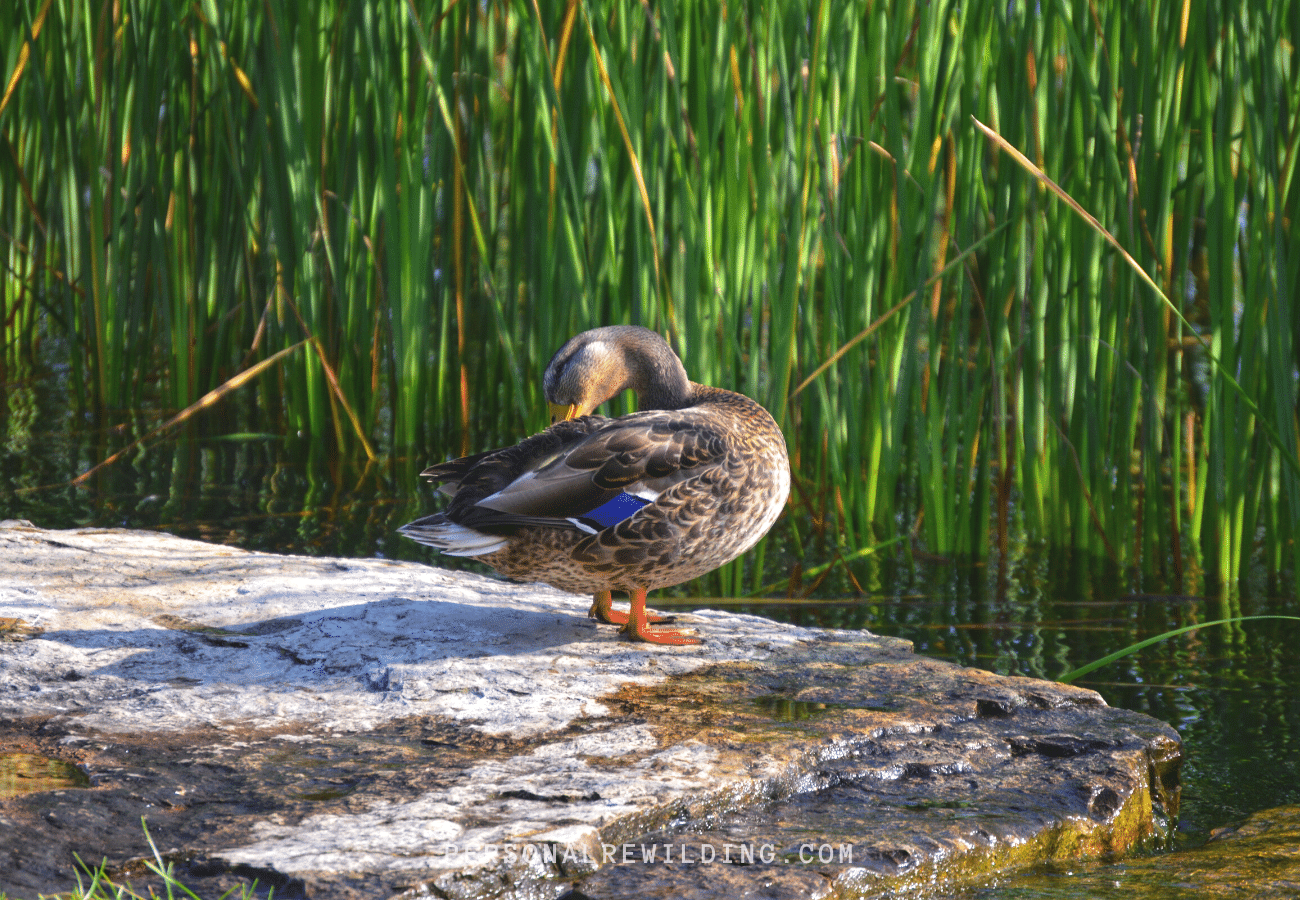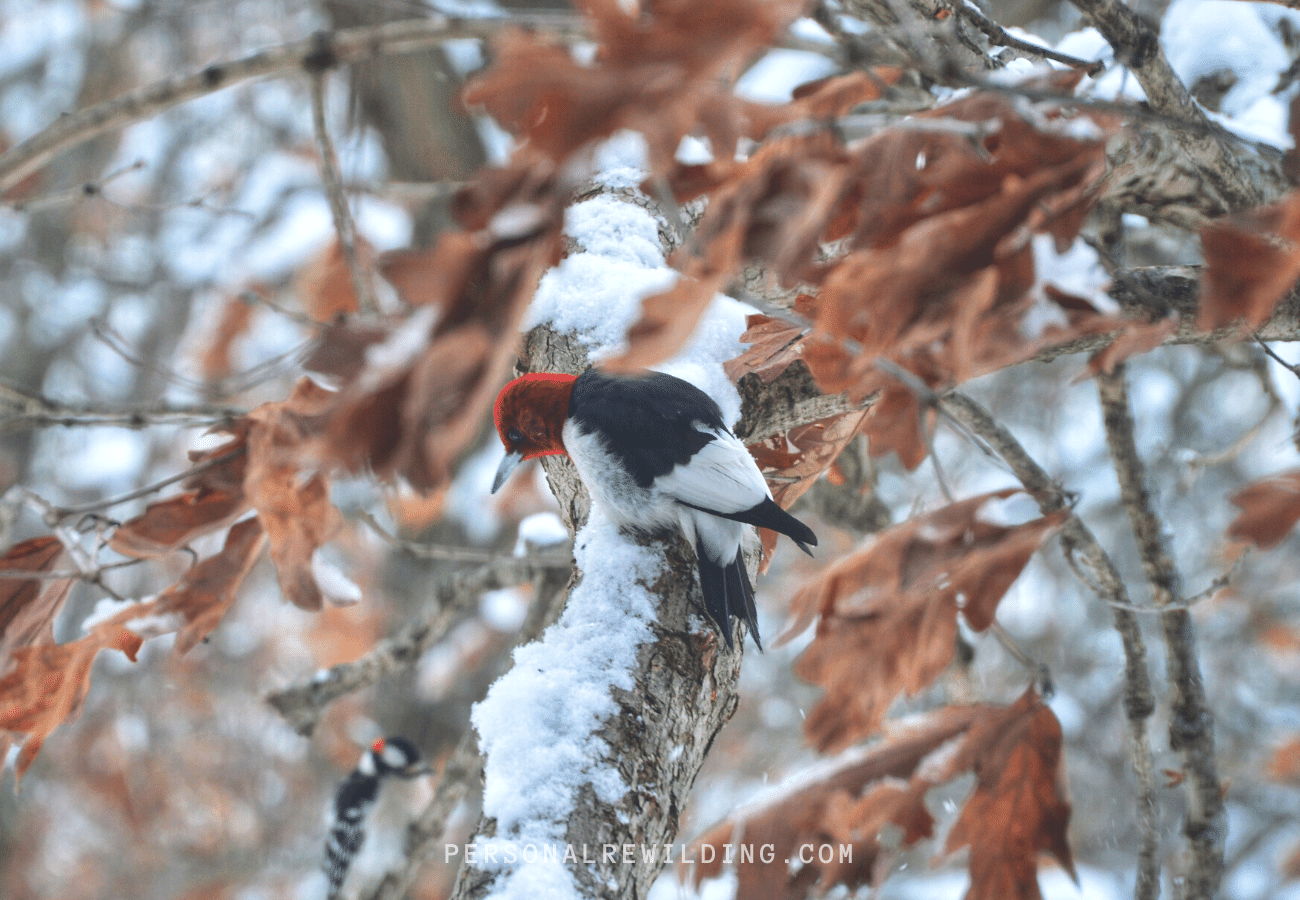- Home
- Connect w/ Nature
- Bird Watching
Bird Watching for Beginners
Bird watching is one of the most therapeutic and relaxing activities I know. In truth, it needn’t be an “activity” at all, but can be carried out from a kitchen window, a lawn chair, or a patio table as easily as from a woodland spot or hiking trail.
Birds are abundant, lively, graceful, colorful, and endlessly captivating to watch. There are thousands of different species with unique songs, quirky and fascinating behaviors, a rainbow of color variations, distinctive shapes, and seasonal migration patterns that are both predictable and mysterious.
Observing birds is healing and helps us to connect with nature and the world around us. They are small, fragile, and vulnerable to so many dangers. Predators, storms, wind, disease – they remind us that life is delicate.
But bird watching also teaches us how to thrive and soar in the face of that vulnerability. Birds sing in the rain. They fluff their feathers and flit about in the snow and the wind. They display exuberance and joy in flight and the routine tasks of their days. They share feeders and congregate in colorful flocks and often work together toward common goals.
Like all new hobbies, bird watching for beginners can be overwhelming. There is so much information out there, some of it contradictory, and much of it too detailed and involved for the novice. Where do you even start?
We’ll try to break it down into simple pieces:
- How to identify different bird species
- How to set up bird feeders and bird baths
- What tools or equipment you might want to own
- How to find local refuges or prime bird watching in your area
“Everyone likes birds. What wild creature is more accessible to our eyes and ears, as close to us and everyone in the world, as universal as a bird?”
-David Attenborough
Benefits of Bird Watching
The benefits of bird watching go beyond simple joy at watching their interplay.
Bird watching rewards patience. Those who truly enjoy the practice find that the wait for that special bird, or just the right angle of light for a photograph, or the hike into the brush required to observe the target, are rewards of their own. Sometimes a gift falls in your lap, but it tastes the sweeter when it requires some sacrifice of time or effort.
Bird watching, when taken beyond a sedentary pursuit, can improve mental and cardiovascular health. The benefits of walking in nature are well documented, and bird watching on foot confers all those same benefits. These include reduced stress and anxiety, lowered blood pressure, improved mood, and improved sleep.
Bird watching can also help you feel more involved as part of a birding community. Bird watchers are a close-knit group, and most areas have groups that meet regularly. Even if you aren’t interested in interacting with a group, birders are often gregarious people that love to talk about what they’ve seen and experienced. You’re sure to run into a friendly birder who will visit, give advice, and help teach you more about your new hobby.
Finally, bird watching gives us a sense of perspective into the lives of other creatures that we share this earth with. It moves us away from our human-centric vision of the world and makes us realize we are part of a greater whole, one worth protecting and preserving.
The world is more than a “resource” for humankind to plunder and mold to our own devices. It is “home” to tens of thousands of species of animal and plant life.
“I came late to the love of birds. For years I saw them only as a tremor at the edge of vision. They know suffering and joy in simple states not possible to us. Their lives quicken and warm to a pulse our hearts can never reach. They race to oblivion. They are old before we have finished growing.”
-J.A. Baker, The Peregrine
How to Identify Birds
One of the most frequent questions I hear from beginning bird watchers is: “How do I identify different birds?” For those without prior experience, this seems an insurmountable obstacle. Birds often look alike, especially from a distance. And for one who is unfamiliar with nomenclature about birds, the names themselves can be daunting.
What’s the difference between a red-bellied woodpecker and a red-headed woodpecker? What clues can you use to tell? And where do you even start learning all the different species and their behaviors?
We urge you to start by learning about the birds in your own backyard. Depending on where you live – location, population density, nearby natural landscape, etc.. – this could be a fairly large variety or a small one. But it will keep your first steps manageable.
Consider putting out a few feeders or a bird bath to attract different varieties to an area where they can be easily viewed from a window or porch/patio.
Observe the bird’s size, colors, behaviors, community (is it alone or amidst a group of like birds?), sounds, location, and any other relevant details. This is the information you will need to make an identification.
Some birds are frequently found at seed feeders. Some are not. Some travel only in groups, while others are loners. Some cling to the sides of trees and even walk upside down, while others are at home on the ground. These are some of the clues you need to identify one species from another.
There are two tools you can use to help you identify species based on the details of what you observe. One is a physical field guide – these can be found online or from just about any bookstore.
Some of the most popular field guides are:
- The Sibley Guide to Birds
- Peterson Field Guide to the Birds of North America
- The National Geographic Field Guide to Birds
- The National Audubon Field Guide to Birds
- Kaufman Field Guide to Birds
Most of these are available either as broad-range guides, for example “Birds of North America” or “Birds of Europe” or as more regional guides such as “Birds of the Eastern U.S.”
We suggest getting the most regionally specific guide possible unless you plan to travel widely, as this will narrow down your selection and make identifying easier. It will also help you to become more familiar with the birds of your immediate area.
The second tool you can use is similar, but possibly makes the identification even easier. There are a variety of apps for smartphones that use your location, along with several questions about the bird you are trying to identify, that will lead you to a likely identification.
The two of these that we recommend are:
We have used Merlin BirdID (developed by the Cornell Lab of Ornithology) fairly exclusively for years and have been very pleased with the information it provides. Your phone provides your location to the app, and the user answers a few simple questions about the relative size of the bird, any notable colors, and its observed location (in a nest, on the ground, at a feeder) and the app provides a list with photos of potential matches.
Which of these tools you prefer is entirely up to you. Sometimes it’s great to have both an app for a quick identification and a physical field guide (for corroboration and more detailed information).
"Let me tell you a story about hope: it always starts and ends with birds."
-Victoria Chang
What Equipment Do You Need for Bird Watching?
Bird watching can be as simple or as in-depth as you choose. If you want to limit yourself to birds at your backyard feeder, all you may need is a couple of simple bird feeders or bird baths to attract a variety of species.
There are, however, several tools that can make bird watching easier and more enjoyable:
Binoculars
Binoculars are a birders best friend, allowing the watcher to get up close and personal with birds from a distance and without disturbing their natural behaviors.
A good pair of binoculars is lightweight, comfortable, and powerful enough to view birds from a comfortable distance. This is going to vary by individual and budget.
A decent pair of binoculars can cost anywhere between $50 - $2000 depending on the internal lens quality and other factors (weight, anti-fog, focus features, etc…). A beginning bird watcher should consider a $50-$125 set of binoculars until they are certain of their commitment to birding as well as understanding the features that are important to them.
For bird watching, we recommend a standard pair of 8x32 or 8x42 binoculars (8 is the magnification, 42 is the size of the lens).
Though greater magnification rates are available – 10x and 12x are not uncommon – most birders prefer 8x magnification lenses due to their wider range of view, which makes it easier to find an object through the viewfinder and to keep the view steady. 32-size lenses are considered mid-size, and are far less bulky than size 42. But 42’s gather more light and make it easier to find an object in the viewer, so personal preference will prevail.
Camera
It’s important to have a good quality camera with a long-range lens if you intend to take photos of birds. Even birds at backyard feeders will be difficult to capture in high quality without a zoom lens.
Even the best smartphone cameras don’t have the zoom capacity on their own to capture great bird photos except on rare occasions. A good DSLR or mirrorless camera with a long range (135mm+) lens is best for capturing distant birds in detail.
For long-range photos, a mounting tripod can help considerably to steady the shot and reduce blurring.
Monocular or Telephoto Lens for Smartphone
One alternative option to a clunky camera that has become popular for birders is a telephoto lens or monocular lens that attaches to a smartphone. This works similarly to a telephoto lens on a standard camera body except it attaches to your phone.
A tripod is still recommended and useful for getting a steady shot.
Bug Spray and Sunscreen
These are a must if you are heading out into the wild for your bird watching adventure!
Wear a hat and apply sunscreen to any uncovered skin to avoid sunburn and decrease your risks of certain types of cancer.
Keep yourself safe from mosquitoes and ticks by using bug spray containing at least 25% DEET. Be sure to spray your legs and ankles (ticks attach from grasses and plants near the ground) as well as exposed areas of skin (neck, arms, etc…) to repel mosquitoes.
Bird Watching in Your Area
Aside from your own backyard or local park, what are some prime bird refuges or bird watching sanctuaries in your area?
Just like with the bird identification, there are some great online tools available to help you find bird watching opportunities and hotspots in your area (or any area you hope to travel in).
eBird.org (like Merlin BirdID, it is run by the Cornell Lab of Ornithology) is an app with an interactive map that indicates bird hotspots set against a background of Google maps. It is easy to use and extremely useful in finding wetlands, wildlife refuge areas, bird sanctuaries, and other wild places where large varieties of birds can be found.
The app is an interactive community, meaning you can upload lists of your observations to their database to help guide other users. It indicates how many varieties of birds have been observed in a given location, along with notes and photos from the observers.
"I felt a calmness birds can bring to people; and, quieted, I sensed here the outlines of the oldest mysteries: the nature and extent of space, the fall of light from the heavens, the pooling of time in the present, as if it were water."
-Barry Lopez, Arctic Dreams






